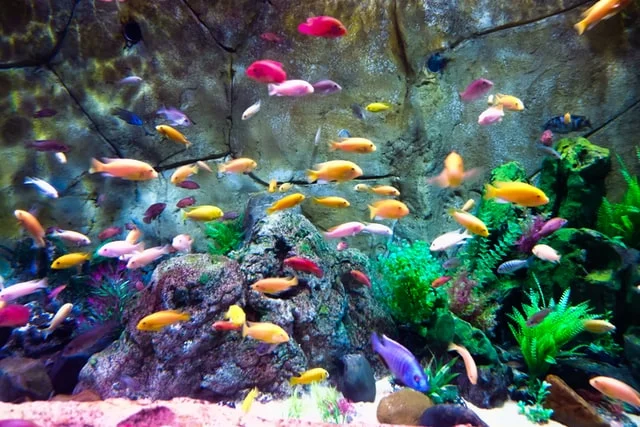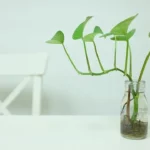Are you thinking of keeping a Pothos in your aquarium? Today, we’ll be looking at how to go about doing that. As well as why you might want to and what kind of fish will benefit from it.
Keeping Pothos in your aquarium can remove nitrates, prevent the growth of algae, provide cover for your fish, and looks incredible!
To use Pothos in a fish tank, you will need to first grow it. Cut off a cutting, let the roots emerge, move it to a bigger vase, wait for it to grow to full size, then move it to the fish tank.
Table of Contents
Why grow Pothos in an Aquarium
Remove Nitrates
You may wish to keep your photos in an Aquarium because it can remove nitrates from the fish tank. The Nitrogen will act as a fertilizer.
Most fish tanks will use Nitrogen to keep the fish alive and well, as well as the plants. However, there needs to be something there to remove the Nitrogen at the end of the nitrogen cycle.
Thankfully, Nitrogen is an excellent fertilizer for Pothos. They use it to make cell repairs and continue growing. It’s a much more eco-friendly alternative to many other methods of removing Nitrogen from the aquarium.
Nitrogen is essential, but it does need to be controlled.
Combats Algae
Talking of Nitrogen, when there is an excess of it, it can cause algae to grow.
The reason why many of us keep aquariums is that we like to look at the fishes. I know many of us like to make up wonderful reasons for keeping fish, but let’s be honest for a second. Most of us keep them because they look nice.
When a fish tank has a lot of Nitrogen and receives too much light, it can become covered in algae. Algae not only stops you from being able to see your fish. It can also out-compete aquatic plants for light, which can have a domino effect on your plants’ ecosystem.
Provides Cover
Pothos can also provide a brilliant cover for your fishes. Firstly, it can protect them from threats that might come from above. This could be cats or things falling into the tank.
It also provides your fish with a safe and secure place for them to lay their eggs. The roots provide a stable structure that can hold the weight of your fishes and their eggs.
If you have a fish who can be a little shy of new people, the Pothos provides a brilliant place for them to hide.
Roots Only
Even though they can be kept in an aquarium, Pothos aren’t actually aquatic plants. Whilst the roots can thrive underwater, the leaves need to stay above the surface.
This could be perfect since most fish are only interested in the leaves- which they can’t reach. The roots are super thick, so there is almost no chance of your fish trying to eat them.
Because the roots provide buoyancy, you will not have to worry about the plant sinking to the bottom of the tank.
Looks Cool
And the final reason why you may wish to keep Pothos in your aquarium is quite simply because they look cool. And yes, I know this does sound a very vain reason to do anything, but surely the whole point of houseplants, and pets such as fish, is that they look cool.
You can feel like you’re close to nature without even having to leave your house. And having plants around your fish tank will make it feel more like they’re in a river than in a small glass box.
If you want to get a plant for no other reason than you like how it looks, we would encourage you to do so!
How to grow a Pothos
The first step to putting Pothos into your aquarium is to grow a Pothos plant. If you have brought a Pothos plant fully grown, feel free to skip over this section.
Propagation
Firstly, you will need to propagate a Pothos plant. You can do this by picking a healthy leaf off another plant. Make sure it’s green, not yellow and not brown.
Once you’ve picked your leaf, cut below the note (that’s the bottom of the leaf, by the way). This will be your “cutting”.
Starting the roots
Place the cutting in a small container, ensuring that the whole of the bottom of the leaf is fully submerged in water. The purpose of this stage is to let the plant know that it is about to have a new root base, and therefore will need to learn where to send the rooting hormones.
After a few weeks, you should start to see some roots emerging. At this stage, the roots will be tiny. These are not here to perform the full function of roots, only to tell the plants where the roots are to go.
Becoming a full plant
Before you move it into the tank, you will need this cutting to grow into a complete plant.
Firstly, select your vase. To prevent a build-up of algae, we would recommend using a dark vase. However, at this stage, it doesn’t matter too much.
Fill the vase up with clean water. When we say clean, we mean free of both dirt and chemicals. Dirt can cause an infection, and chemicals will simply kill it. Filtered tap water will do the job for most people.
With your vase full of water, add your fertilizer based on what the packet recommends.
Whilst it’s growing, you may need to change the water every 2-3 weeks. In the wild, plants’ water gets changed by the river moving along. However, at home, you will need to give it a hand.
Every 4-6 weeks, you will need to add a bit more fertilizer. This is to keep the plant happy and healthy and make sure it always has enough Nitrogen.
At all times, make sure the roots stay below the water.
You could grow it in soil. However, when you move it to the aquarium, it might struggle to adapt to the new environment.
Transferring to the Aquarium
The next stage will be to move your Pothos from the vase to the aquarium. You will need to be careful at this stage, as you always need to be when moving a whole plant.
The thing to remember is to take your time. Doing it properly is more important than doing it quickly.
The Nitrogen in the tank should mimic the fertilizer that you used to give it in the vase. Depending on what kind of fish you have, they may take a bit of time to adapt to this new plant. But eventually, it will become part of their furniture.
About the Pothos and your Fishes
Pothos is Toxic to fish
This seems to be like the perfect time to say that Pothos is actually toxic to fish. Yes, you heard that write. I have just written an article telling you how to put a plant into your aquarium that would be toxic for your fish.
For this reason, you mustn’t put your trimming directly into the fish tank. The sap will be too easy for your fish to access, and the leaves will float on the surface- an ideal but deadly snack.
If you trim your Pothos, be sure that none falls down into the tank.
It doesn’t matter that Pothos is Toxic to fish
However, I have not just written that section to put you off. Whilst it’s true that Pothos is toxic to fish, bleach is harmful to humans- but only if we consume it.
The position in Pothos is locked away inside. The only part soft enough for your fish to eat through will be the leaves, which are kept above the surface.
The roots are far too thick for your fish to even attempt to eat them. This is why Pothos is such a brilliant plant to keep in an aquarium.
Fish that LOVE Pothos
The kind of fish that benefit most from Pothos will be Omnivorous fish. That means fish who eat both flesh and vegetation.
Here are a few examples of fishes that would be very happy to see some Pothos come into their home.
Goldfish
Parrot fishes
Clownfish
Angel fish
Zebra Danios
There are, of course, plenty of other fish who would also like Pothos. However, I have listed these because they are the kinds of fish that are most popular with fish keepers. Pothos is excellent at maintaining the sort of environment that these fish will thrive in.
Conclusion
And that is the why and how of keeping Pothos in your aquarium. There are many benefits to both yourself and your fish. Plus, it’s incredibly easy to do.
Once your Pothos is in the tank, your fish will be happy to have all that excess Nitrogen cleared away, and they certainly won’t miss the algae that the Pothos has kept away. And for yourself, you can look at a fish tank that looks like it was scooped right out of nature itself.
If you want to combine your love of fishes with your love of houseplants, growing a Pothos
Photo by Joshua Dewey on Unsplash



